History of Palau
For the first time, Palau was probably sighted by Europeans early as 1522, when the Spanish mission of the Trinidad, the flagship of Ferdinand Magellan's voyage of circumnavigation, sighted two small islands around the 5th parallel north, naming them "San Juan" without visiting them.
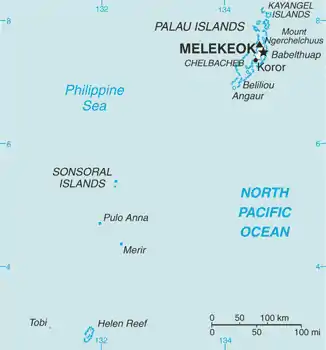
Palau was initially settled around 1000 BC.
Palau was truly discovered by the Europeans on 28 December 1696 when the first map of Palau was drawn by the Czech missionary Paul Klein[1] based on a description given by a group of Palauans shipwrecked on the Philippine coast on Samar. This map and a letter sent to Europe by Klein in June 1697 had a vast impact on the surge of interest in Palau. It resulted in the first and failed the Jesuit attempts to travel to the islands from the Philippines in 1700, 1708 and 1709. The islands were first visited by the Jesuit expedition led by Francisco Padilla on 30 November 1710, only to leave 2 stranded priests Jacques Du Beron and Joseph Cortyl on the coast of Sonsorol, while the mother ship Santissima Trinidad was being swept away by a storm. Subsequent attempts to save Du Beron and Cortyl learned that they were killed and eaten by the locals.
After further attempts, Palau islands were made part of the Spanish East Indies in 1885. Following Spain's defeat in the Spanish–American War in 1898, the islands were sold to Imperial Germany in 1899 under the terms of the German–Spanish Treaty, where they were administered as part of German New Guinea. British traders became prominent visitors in the 18th century, followed by expanding Spanish influence in the 19th century. Following its defeat in the Spanish–American War, Spain sold Palau and most of the rest of the Caroline Islands to Germany in 1899. Control passed to Japan in 1914 and during World War II the islands were taken by the United States in 1944, with the costly Battle of Peleliu between September 15 and November 25 with more than 2,000 Americans and 10,000 Japanese killed. The islands passed formally to the United States under United Nations auspices in 1947 as part of the Trust Territory of the Pacific Islands.
Four of the Trust Territory districts formed a single federated Micronesian state in 1979, but the districts of Palau and the Marshall Islands declined to participate. Palau, the westernmost cluster of the Caroline Islands, instead opted for independent status in 1978, approved a new constitution and became the Republic of Palau in 1981, and signed a Compact of Free Association with the United States in 1982. After eight referendums and an amendment to the Palauan constitution, the Compact was ratified in 1993 and went into effect on October 1, 1994, marking Palau independent de jure (after Palau was independent de facto since May 25, 1994, when the trusteeship cancelled).
Legislation making Palau an "offshore" financial center was passed by the Senate in 1998. In 2001, Palau passed its first bank regulation and anti-money laundering laws.[2]
Archaeology
Carbon dating of cave burials show a pygmy population, presumably the result of insular dwarfism, from at least 3,000, and perhaps as long as 4,500 years ago until about 900 years ago (1000–2500 BCE until ca. 1100 CE).[3]
Pre-contact
The Palauan language is an outlier among the Austronesian languages, and so does not shed much light on the origins of the modern population. However, there are some indications that it may derive from the Sunda Islands (modern Indonesia).
For thousands of years, Palauans have had a well established matrilineal society, believed to have descended from Javanese precedents.[4] Traditionally land, money, and titles passed through the female line. Only High Ranking Women (Queens) hand picked the High Chiefs. Clan lands continue to be passed through titled women and first daughters[5] but there is also a modern patrilineal sentiment introduced by imperial Japan. The Japanese government attempted to confiscate and redistribute tribal land into personal ownership during World War II, and there has been little attempt to restore the old order. Legal entanglements continue amongst the various clans.
European contact and discovery in 1696
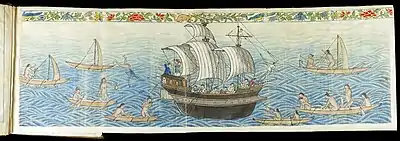
There still is a debate whether the islands were or were not seen by some of the early European discoverers in the 16th century. Historians take note of the early navigational routes of European explorers in the Pacific. There is disagreement as to whether Spaniard Ruy López de Villalobos, who landed in several Caroline Islands, spotted the Palau archipelago in 1543. No conclusive evidence exists, but some believe he could have seen the tip of a southernmost island in the group.

Nevertheless, the true and conscious discovery of Palau came a century later in December 1696, when a group of islanders shipwrecked on the Philippines island of Samar. They were interviewed by the Czech missionary Paul Klein on 28 December 1696. Klein was not only able to draw the first map of Palau based on a drawing and a set of pebbles on the beach but also to send an important letter in June 1697[6] to Europe. This map and the letter caused a vast interest in the new islands and resulted in the first and failed Jesuit attempts to travel to Palau from the Philippines in 1700, 1708 and 1709.[1]
The islands were first visited by the Jesuit expedition led by Francisco Padilla on 30 November 1710, only to leave two stranded priests Jacques Du Beron and Joseph Cortyl on the coast of Sonsorol, while the mother ship Santissima Trinidad was being swept away by a storm.[1] Spain later started to dominate the islands.
Palau had also limited relations with the exterior before the 18th century, mainly with Yap and Java. Had it not been for shipwrecked islanders who took refuge in the Philippines in 1696, Europeans likely would not have found Palau until much later.
Englishman Henry Wilson, captain of the East India Company's packet ship Antelope, was shipwrecked off the island of Ulong in 1783. The High Chief of (Koror) Palau allowed Captain Wilson to take his son, Prince Lee Boo, to England, where he arrived in 1784. However, the prince died soon after of smallpox. The East India Company erected a monument over his grave in St Mary's Churchyard, Rotherhithe. It was Wilson who gave the archipelago the name "Pelew Islands".
Spanish rule
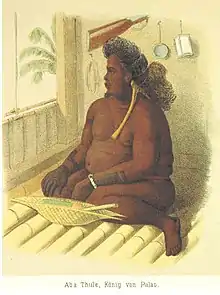

In the late 19th century, possession of the islands was claimed by Britain, Spain, and Imperial Germany. In 1885, the matter was brought to Pope Leo XIII for a decision. The Pope recognized the Spanish claim, but granted economic concessions to Britain and Germany. Palau then became part of the Spanish East Indies, along with the Mariana Islands, the Marshall Islands. and the rest of the Caroline Islands. They were all administered from the Philippines.
After being defeated in 1898 in the Spanish–American War and losing possession of the Philippine Islands, Spain sold the Palau archipelago to Imperial Germany in the 1899 German–Spanish Treaty.[7][8]
German era

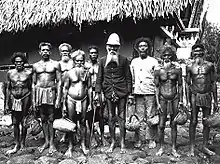
Palau was administered from German New Guinea, and a period of economic development began. German engineers began exploiting the islands' deposits of bauxite and phosphate, and a rich harvest in copra was made.
Japanese mandate

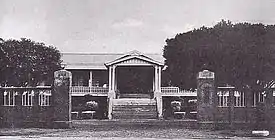
Under the terms of the Anglo-Japanese Alliance, the Empire of Japan declared war on the German Empire in 1914 and invaded German colonial empire in the Pacific Ocean. Palau was seized by ships of the Imperial Japanese Navy. After the war, the League of Nations awarded Palau to Japan as a Class C League of Nations Mandate.[9]
Japan incorporated the islands as an integral part of its empire, establishing the Nanyo-cho government with Koror Island as the capital.[10] From 1914 to 1922, the Japanese Imperial Navy had been in control. Civilian control was introduced from 1922, and Palau was one of six administrative districts within the Mandate. Japan mounted an aggressive economic development program and promoted large scale immigration by Japanese, Okinawans and Koreans. Native Palauans soon became a small minority in their own homeland. The Japanese continued the German mining activities, and also established bonito (skipjack tuna) canning and copra processing plants in Palau.
World War II
The Japanese presence made Palau a major target for the Allied forces in World War II. Peleliu was a scene of intense fighting between American and Japanese forces in 1944. The battle ended in an Allied victory, but at a high cost for both sides. At the end of the Pacific War, less than five thousand Palauans were left alive with many Palauan families adopting Japanese children into their midst (those refused passage back to Japan as they were too young and dangerous to travel). All surviving Japanese were repatriated after the end of the war. There are still about 100 American servicemen listed as Missing In Action in Palau. Starting in 1993, a small group of American volunteers called The BentProp Project has searched the waters and jungles of Palau for information that could lead to the identification and recovery of these remains. The Palauan people, in recognition of the basic human hospitality that is unique to all people of the islands all over the planet, allowed the Japanese and US governments to search for their missing soldiers as well as bringing back their remains.
Post-war development
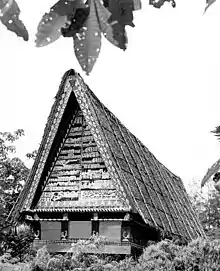
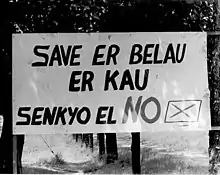
In 1947, the United Nations decided the United States would administer Palau as part of the Trust Territory of the Pacific Islands. In 1979, Palauans voted against joining the Federated States of Micronesia, the Marshall Islands and the Marianas (except Guam) because of language and cultural differences. A long period of transition occurred between 1979 and 1994, specifically in the capital, Koror, on the topic of relations with the United States. After a long period of transition, including the violent deaths of two presidents (Haruo Remeliik in 1985 and Lazarus Salii in 1988), Palau voted in 1994 to freely associate with the United States while retaining independence under the Compact of Free Association.

See also
References
- Francis X. Hezel, SJ. "Catholic Missions in the Carolines and Marshall Islands". Retrieved 15 January 2015.
- "United States Department of State Palau Archives". United States Department of State. Retrieved 29 January 2018.
- Lee R. Berger, Steven E. Churchill, Bonita De Klerk1, Rhonda L. Quinn (March 2008). "Small-Bodied Humans from Palau, Micronesia". PLoS ONE. 3 (3): e1780. Bibcode:2008PLoSO...3.1780B. doi:10.1371/journal.pone.0001780. PMC 2268239. PMID 18347737.CS1 maint: multiple names: authors list (link)
- "About Palau | Palau travel guides | Journeum". www.journeum.com. Retrieved 2018-01-04.
- "Palau National Communications Corporation". Archived from the original on 2011-07-09. Retrieved 2011-01-03.
- https://books.google.com.ph/books?id=Q-6StnGKAIQC&pg=PR132&dq=pablo+clain+carta&hl=en&sa=X&ei=L-6-VMXTNovq8gW52ICQDg&ved=0CB0Q6AEwAA#v=onepage&q=pablo%20clain%20carta&f=false Los siete principes de los Angeles: validos del Rey del cielo. Misioneros, y protectores de la Tierra, con la practica de su deuocion Andres Serrano ((S.I.)), 1707
- Sandafayre.com on Palauan history
- United States Department of State article on Palau
- Peatty, 'Nan'Yo: The Rise and Fall of the Japanese in Micronesia
- Beasley, Japanese Imperialism